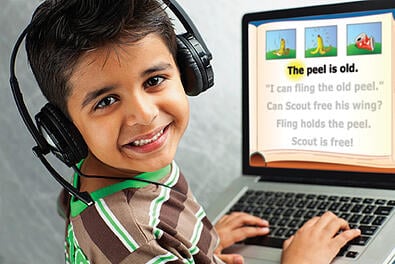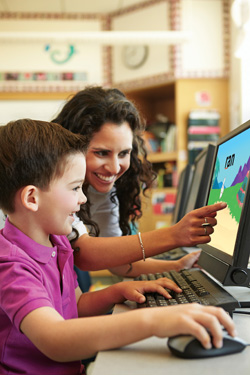Learning to read is arguably the most critical educational accomplishment for all young students. To be successful in any subject area, students must be able to read and comprehend text. But when is the right time to begin teaching these essential skills? Many believe that it's best to start teaching reading skills as soon as possible, but how should educators begin the process? In this article we will look at what the evidence tells us about teaching young learners to read, identify some resources that may be available to assist in this effort, and explain how the Web-based MimioSprout early reading software can be used to address new standards as well as utilize new funding sources.
New Rigor in Primary Grades Calls for Enhanced Pre-K Curriculum

The Challenge to Our Schools
While optimizing the elementary school curriculum to meet new expectations will be necessary, the wide range of learners’ entering readiness skills poses a significant challenge to the early primary teacher, administrator, and school district as a whole. As Hart & Risley (1995) famously reported, the language gaps among 3-year-olds predicted academic achievement gaps observed in third Grade. Many states are now using 3rd Grade assessment scores as measuring sticks for early literacy performance. In some cases, students must pass a state literacy exam at the end of 3rd Grade in order to move on to 4th. Not surprisingly, the National Association for the Education of Young Children (NAEYC) and the International Reading Association have emphasized the need for additional early childhood resources to further support at-risk students.
What the Research Says

Huffstetter, King, Onwuegbuzie, Schneider, and Powell-Smith (2010) recently published a peer-reviewed study investigating the effects of MimioSprout early reading on Pre-K oral language and early literacy development with at-risk Pre-K students* Results of the study showed that students who participated in MimioSprout early reading for just eight weeks made significantly larger gains on the Test of Early Reading Ability (TERA-3) and the Test of Language Development-Primary (TOLD-P:3) than students in a control group. Read the full abstract.
*At the time, the program was named Headsprout Early Reading
Race to the Top: Early Learning Challenge
The American Recovery and Reinvestment Act of 2009 (ARRA) set aside $4.35 billion to fund Race to the Top – a competitive federal grant awarded to states based on their proposals to implement comprehensive education reform plans. In response to the call from both researchers and educational agencies to focus more effort on the prevention of academic achievement gaps, the Race to the Top - Early Learning Challenge awarded grants to nine states in 2011-2012.
Table 1. Allocation of Awards (FY 2011 Funds)
| State | 2011-2012 Awards |
| California | $52,572,935 |
| Delaware | $49,878,774 |
| Maryland | $49,999,143 |
| Massachusetts | $50,000,000 |
| Minnesota | $44,858,313 |
| North Carolina | $69,991,121 |
| Ohio | $69,993,362 |
| Rhode Island | $50,000,000 |
| Washington | $60,000,000 |
Data retrieved from: http://www2.ed.gov/programs/racetothetop-earlylearningchallenge/awards.html
Awards were based on the proposers’ plans to (1) increase enrollment in high-quality early childhood programs amongst disadvantaged students, (2) improve learning systems for the students enrolled, and (3) employ assessment and accountability protocols. Further, there must be evidence to support the efficacy of proposed plans. Learn more about Race to the Top – Early Learning Challenge eligibility and timelines.
Teach Pre-K Students to Read with MimioSprout
A wealth of research suggests that it may be a good idea to start teaching students how to read before they enter kindergarten (e.g., Blook, Oostam, Otter, & Overmaat, 2002; Lonigan, McDowell, & Phillips, 2004). Once students enter kindergarten, the increased rigor required by new state standards further necessitates an early literacy foundation. The calls from a number of educational organizations to adequately fund early childhood development have been partially answered, as more and more states are receiving awards based on their plans to improve the effectiveness of instruction. MimioSprout helps to improve learning systems through patented, individualized, and evidence-based instruction that meets the challenge to teach young students how to read and comprehend text.
Have a question for Patrick? Please leave a comment below!
Or, Contact a MimioReading Specialist To Learn More:
References
Blok, H., Oostdam, R., Otter, M.E., & Overmaat, M. (2002). Computer-assisted instruction in support of beginning reading instruction: A review. Review of Educational Research, 72, 101-130.
Camilli, G., Vargas, S., Ryan, S., & Barnett, W.S. (2010). Meta-analysis of early education interventions on cognitive and social development. Teachers College Record, 112(3), 579-620.
Hart, B., & Risley, T.R., (1995). Meaningful differences in the everyday experience of young American children. Baltimore, MD: Paul H. Brookes.
Huffstetter, M., King, J.R., Onwuegbuzie, A.J., Schneider J.J., & Powell-Smith, K.A. (2010). Effects of a computer-based early reading program on the early reading and oral language skills of at-risk preschool children. Journal of Education for Students Placed at Risk, 15, 279-298.
Jacobs, R.T., Creps, C.L., & Boulay, B. (2004, July). Meta-analysis of research and evaluation studies in early childhood education (Final report to the National Institute of Early Education Research). Cambridge, MA: Abt. Associates.
Layng, J., Twyman, J.S., & Stikeleather, G. (2004). Selected for success: How Headsprout Reading Basics teaches children to read. In D.J. Moran & R. Malott (Eds.), Evidence-based education methods (pp.171-197). St. Louis, MO: Elsiver Science/Academic Press.
Lonigan, C.J., McDowell, K.D., & Phillips, B.M. (2004). Standardized assessments of children’s emergent literacy skills. In B.H. Wasik (Ed.), Handbook of family literacy (pp. 525-550). Mahwah, NJ: Lawrence Erlbaum Associates.
National Association for the Education of Young Children and International Reading Association (2009). Where we stand on learning to read and write. Retrieved from http://www.naeyc.org/positionstatements/learning_readwrite
National Governors Association Center for Best Practices and Council of Chief State School Officers, Washnington D.C. (2010). Common core state standards. Retrieved from http://www.corestandards.org/the-standards
United States Department of Education (2012). Retrieved from http://www2.ed.gov/programs/racetothetop-earlylearningchallenge/awards.html